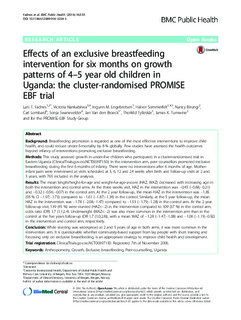| dc.contributor.author | Fadnes, Lars T. | |
| dc.contributor.author | Nankabirwa, Victoria | |
| dc.contributor.author | Engebretsen, Ingunn Marie S. | |
| dc.contributor.author | Sommerfelt, Halvor | |
| dc.contributor.author | Birungi, Nancy | |
| dc.contributor.author | Lombard, Carl | |
| dc.contributor.author | Swanevelder, Sonja | |
| dc.contributor.author | Van den Broeck, Jan | |
| dc.contributor.author | Tylleskär, Thorkild | |
| dc.contributor.author | Tumwine, James K | |
| dc.date.accessioned | 2017-02-22T12:20:12Z | |
| dc.date.available | 2017-02-22T12:20:12Z | |
| dc.date.created | 2016-08-23T12:36:17Z | |
| dc.date.issued | 2016 | |
| dc.identifier.citation | BMC Public Health. 2016, 16 . | |
| dc.identifier.issn | 1471-2458 | |
| dc.identifier.uri | http://hdl.handle.net/11250/2431736 | |
| dc.description.abstract | BACKGROUND: Breastfeeding promotion is regarded as one of the most effective interventions to improve child health, and could reduce under-5-mortality by 8 % globally. Few studies have assessed the health outcomes beyond infancy of interventions promoting exclusive breastfeeding. METHODS: This study assessed growth in under-five children who participated in a cluster-randomised trial in Eastern Uganda (ClinicalTrials.gov.no.NCT00397150). In the intervention arm, peer counsellors promoted exclusive breastfeeding during the first 6 months of infancy. There were no interventions after 6 months of age. Mother-infant pairs were interviewed at visits scheduled at 3, 6, 12 and 24 weeks after birth and follow-up visits at 2 and 5 years, with 765 included in the analyses. RESULTS: The mean length/height-for-age and weight-for-age-z-score (HAZ, WAZ) decreased with increasing age in both the intervention and control arms. At the three weeks visit, HAZ in the intervention was -0.45 (-0.68;-0.21) and -0.32 (-0.56;-0.07) in the control arm. At the 2 year follow-up, the mean HAZ in the intervention was -1.85 (95 % CI -1.97;-1.73) compared to -1.61 (-1.87;-1.34) in the control. Similarly, at the 5 year follow-up, the mean HAZ in the intervention was -1.78 (-2.08;-1.47) compared to -1.53 (-1.79;-1.28) in the control arm. At the 2 year follow-up visit, 139 (45 %) were stunted (HAZ<-2) in the intervention compared to 109 (37 %) in the control arm, odds ratio (OR) 1.7 (1.1;2.4). Underweight (WAZ<-2) was also more common in the intervention arm than in the control at the five years follow-up (OR 1.7 (1.0;2.8)), with a mean WAZ of -1.28 (-1.47;-1.08) and -1.06 (-1.19;-0.92) in the intervention and control arm, respectively. CONCLUSION: While stunting was widespread at 2 and 5 years of age in both arms, it was more common in the intervention arm. It is questionable whether community-based support from lay people with short training and focussing only on exclusive breastfeeding, is an appropriate strategy to improve child health and development. TRIAL REGISTRATION: ClinicalTrials.gov.no. NCT00397150 . Registered 7th of November 2006. | |
| dc.language.iso | eng | |
| dc.relation.uri | http://bmcpublichealth.biomedcentral.com/articles/10.1186/s12889-016-3234-3 | |
| dc.title | Effects of an exclusive breastfeeding intervention for six months on growth patterns of 4-5 year old children in Uganda: The cluster-randomised PROMISE EBF trial | |
| dc.type | Peer reviewed | |
| dc.type | Journal article | |
| dc.source.pagenumber | 9 | |
| dc.source.volume | 16 | |
| dc.source.journal | BMC Public Health | |
| dc.identifier.doi | 10.1186/s12889-016-3234-3 | |
| dc.identifier.cristin | 1374839 | |
| dc.relation.project | Norges forskningsråd: 223269 | |
| cristin.unitcode | 7502,7,2,4 | |
| cristin.unitname | Global helse for kvinner og barn | |
| cristin.ispublished | true | |
| cristin.fulltext | original | |
| cristin.qualitycode | 1 | |
